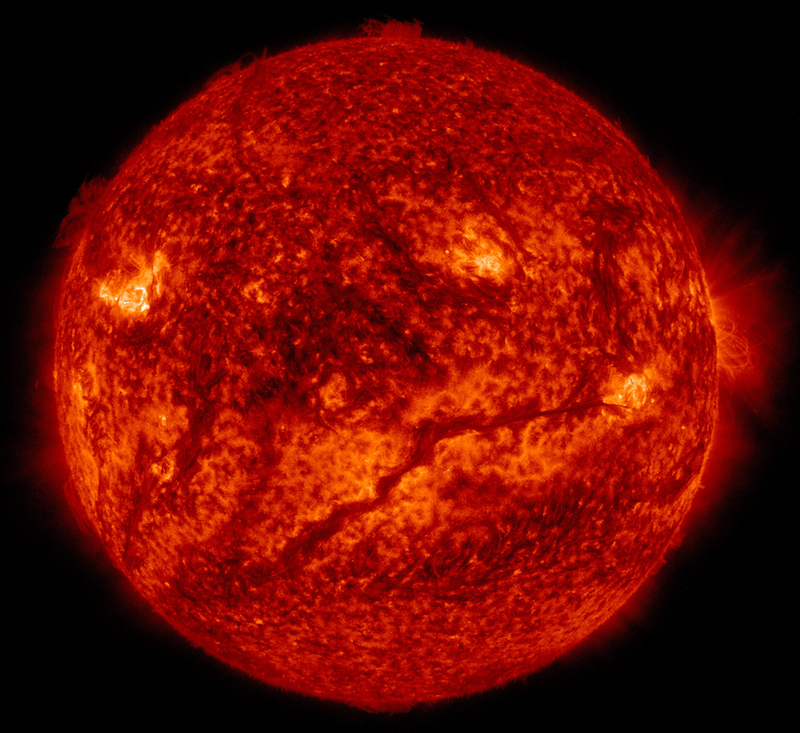Photons Brake the Sun
The Sun’s surface mysteriously rotates more slowly than its interior. Now researchers have observed the phenomenon with high resolution and proposed an explanation for the behavior. Using a new technique that tracks waves moving through the outer layers of the Sun, the team confirmed the speed difference and attributed the slowdown to the Sun’s outer, 70-km “skin.” Their model proposes that photons radiated from this layer extract angular momentum, slowing down the rotation. According to the researchers, such a slowdown should occur in all stars and could have a greater effect on larger stars.
The rotation rate of the Sun’s plasma varies with latitude—faster at the equator than at the poles—and with distance from the core. Solar researchers noticed the core-surface speed difference decades ago but do not yet have a widely-accepted explanation.
Researchers have measured the plasma rotation rate vs depth within the Sun using a technique called helioseismology, where observations of the vibrating solar surface, driven by acoustic waves through the core, provide information on the interior. But these measurements covered the entire Sun, and the resolution was relatively low, at 2000 km.
To get a more detailed look at the slowdown of the Sun’s surface, Jeff Kuhn, of the University of Hawaii in Pukalani, and his colleagues used images of the outer edge of the Sun—essentially, the Sun's silhouette. The images were acquired continuously over 3.5 years, starting in 2010, by NASA’s Solar Dynamics Observatory spacecraft. To observe a range of depths within the photosphere—the 500-km-thick, semi-transparent, outer layer of the Sun—the team used images taken with filters for slightly different wavelengths. For each wavelength (representing a different depth, thanks to temperature variations), the researchers measured the motion of ripples at the edge of the solar disk in order to infer the rotation speed. “It is analogous to watching ocean waves in the presence of ocean currents” and then determining the current from the wave motion, says Kuhn. The team measured the Sun’s outer 150 km with 10-km resolution and found that most of the rotation slowdown happens in a 70-km skin that is rotating about 5% slower than the rest of the photosphere.
Kuhn and his colleagues also developed a model to explain their data. Photons are created in the Sun’s dense core, where the plasma behaves nearly like a solid. As they diffuse outward, they experience plasma that is less dense, faster flowing, and subject to turbulent convection. As the photons interact with the moving plasma, they exchange angular momentum with it. Inside the Sun, the photons scatter so frequently that they lose as much angular momentum as they gain. But in the photosphere, where photons escape the Sun, the plasma-photon momentum transfer results in a net loss of the plasma’s angular momentum, as photons radiate away. The effect on the plasma is a mild braking force, which slows its overall rotation. This braking is most effective at the outer edge of the Sun, where the plasma density is at its lowest.
The researchers calculated the photosphere rotation speed implied by their photon-braking effect and found good agreement with their solar observations. The effect on the full Sun’s rotation period, however, is likely minimal, says Kuhn. The photon-braking mechanism would take “many times the age of the Universe” to change the rotation speed of the Sun’s core, he says, but for brighter stars, which radiate more photons, the effect could be much greater.
“The physical model developed is clearly speculative,” says Astronomer Jørgen Christensen-Dalsgaard of Aarhus University in Denmark, but it is “not unreasonable.” As for the detailed measurements of rotation vs radial distance in the photosphere, “No other technique has been able to resolve this variation,” he says. “This is undoubtedly an important contribution to our understanding of the dynamics of the Sun.”
This research is published in Physical Review Letters.
–Katherine Wright
Katherine Wright is the Deputy Editor of Physics Magazine.





